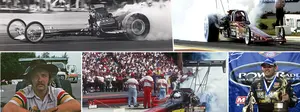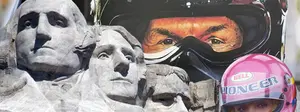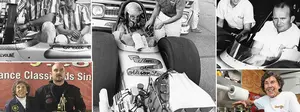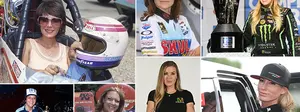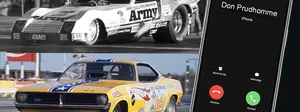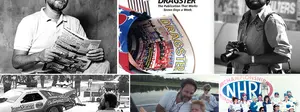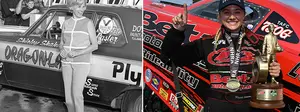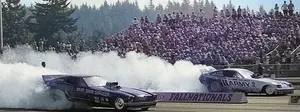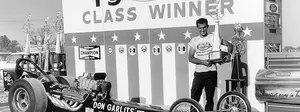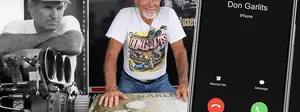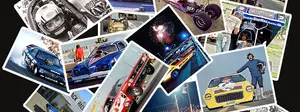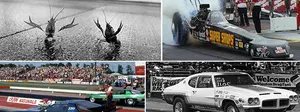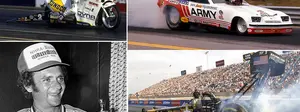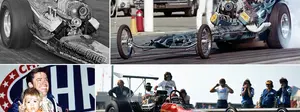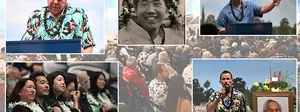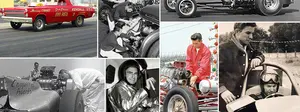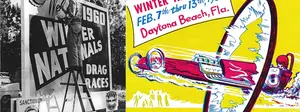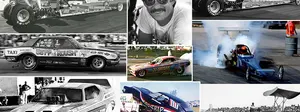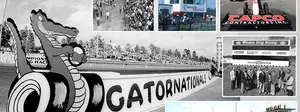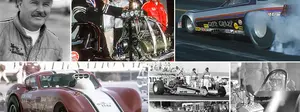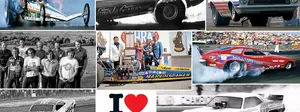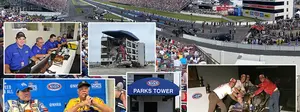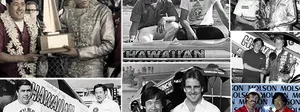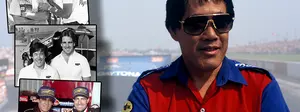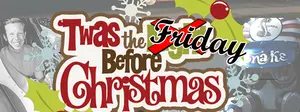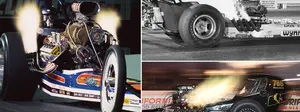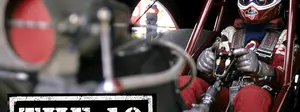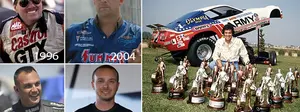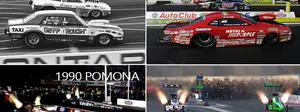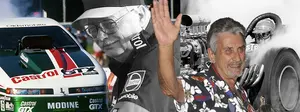Mickey Thompson's Grand Am, Part 2
 |
After a somewhat tumultuous debut in 1973 that included driver Dale Pulde’s sudden replacement before the season opener and a nasty fire that sidelined his replacement, Butch Maas, and allowed Pulde to hop back into the saddle of Mickey Thompson’s Grand Am Funny Car, the 1974 season seemed like a good time to start over, beginning with Pulde’s extensive revamping of the Grand Am’s body.
Pulde got two more bodies from Ron Pellegrini and had master craftsman Hank Buck change the bodies.
“I laid the roof back, bowed the back down a little, and took some weight out of it and had Bill Carter paint it black with some colored graphics,” recalled Pulde. “It looked real racy, and the fans and racers loved it. NHRA didn’t like it as much. The rules said you couldn’t chop the top but didn’t say anything about laying the roof back; it was at the right height, just laid back, but the black paint just made it look even more sleek and even illegal. They said I could run it but just don’t do it the next time, but we’d already done the same thing to both bodies so we were screwed, and the funny thing is that later that year, when I painted the second body red, it passed through tech with no problem. Same body, different paint. Weird.”
(Little known fact: Pulde himself painted the grille and headlights on the original yellow car in his front yard. “It had such a small grille, it was no big deal; just a couple of black spots with some silver lines in it and went around the headlights with silver and black paint. If it had a major grille in it, I would have been in deep trouble.”)
 |
The car not only looked racy, but ran well, too, at least in the beginning.
“That season, I was running pretty decent, then I think I invented dropping cylinders,” he said. “I tried everything I could to solve the problem in a conventional manner; however, nothing seemed to work. I could still run good, but the motor would be a dead player at the top end.”
The woes continued – and got a bit worse – during a match race at Great Lakes Dragaway during the Fourth of July weekend, but the bad outing actually ended up pointing Pulde in the right direction.
“I blew a blower and took the rear tire off the car and ran it into the trees,” he said. “The car needed to be fronthalved, but instead of dragging it back to California, I went to Romeo Palamides, who did the work. We were sitting there looking at the chassis, which still had the longer front end, and I asked him how hard it would be to put the fuel tank in front of the axle. I knew that would put another 60 pounds out there.
 |
“The late Don Madden of Howard Cams told me about the Chevy guys reversing the rotors in the blower to make the fuel drive in the other direction. I tried that, and instead of dropping the two rear cylinders, I was down to dropping only one up front, which was much easier to tune around. By the end of the year, I had it running good again.”
And then some. Pulde was back in action in time for Indy – with the car painted a vibrant red – and had a hand in deciding that year’s world championship as it was he who defeated Don Prudhomme in the second round of the World Finals to secure the title for Shirl Greer. Pulde did it in impressive fashion with a national record blast of 6.16, 233.76 mph.
Assisting Pulde at the event was veteran Funny Car racer Larry Arnold, who had been working for Thompson on his off-road racing vehicles and had already agreed to take over the driving reins in 1975. In an all-too-familiar story for guys driving for Thompson, the winning percentages never covered the operating costs that MT required they pay, and Pulde had had enough.
 |
“I'd had enough of touring and all of the work and trying to put up with the help I had to hire,” he confessed. “It was a hard year. The car did good for Mickey but not a lot for Dale. The way it worked with Mickey was that you take care of the upkeep on the car and parts – you had to return the car at year’s end in the same working order you got it – and we split all the motel and gas bills, and he got half the winnings. But all of the day-to-day BS, that's what you ended up with. The Chevy duallie we had was like the sixth one ever made, and it was a pile of crap. That was one of the fighting points I had. I spent more money fixing it than I could have spent making payments. That year was more than a season racing; it was a college education on what not to do. Mickey was good to me, and I never would have gotten where I got to without him, but I don’t think we always saw eye to eye on the financial end of running the car.
“Coming into Ontario [Calif.], I had already told him I was done. I showed up at Ontario alone, sick of all of it, sick of the crew guys. I wasn't kissing anyone's ass anymore. I'd just find someone to start the car; whatever I needed to do, I’d make it work. I was at home and had a lot of friends. When I left, it was a pretty good car. We got it down on weight and made the car really stable for a big car. It had that long deck on the back. It was a pretty neat car, and I knew whoever got it would have a good race car.
"Arnold showed up on my last qualifying pass and helped me from there on. He said, ‘You don’t lean on this thing do you?’ and I said, 'I can’t afford it.' But I said, 'I'm done with it; let’s let it happen, and we stood on it, and it ran good. He got the car after I walked out."
After finishing the year’s match race schedule, Pulde turned it over to Arnold, who played a big role in bringing the U.S. Marines aboard to sponsor the car in 1975.
“Mickey was not interested in putting money into drag racing, so we talked about putting someone else's money in to pay for the car,” said Arnold. “I had been thinking the Marines would be a perfect sponsor – going head to head with the Army would be a great draw. When contacted, the Marines agreed.”
 |
Arnold had a literal trial by fire in his debut in the new car during a photo shoot at Orange County Int’l Raceway for the Marines that put him in the burn ward.
“They wanted shots of the car to hand out at the Winternationals. I took a run, and burned piston and ignited the car. It damaged the tin and needed a new paint job and a new motor. It was fixed and ready for the race, but I was not so lucky. By the time of the race, I was out of the burn ward, but the burns on my back were too painful to get in the car."
His pal Charlie Therwanger subbed for him at the Winternationals, where he reached the semifinals before losing an armed-forces clash with Prudhomme’s new Army Monza. Arnold was back in the car for the Gatornationals, where he qualified fifth but lost in round one. He also ran a couple of match races with the car before he, too, decided he didn’t like the business arrangement with Thompson and handed the car back to MT.
“I stopped for the same reason that Pulde did,” he said. “Mickey would not put adequate money into drag racing, even with the Marines sponsorship. The truck was a disgrace; I had inadequate parts. I was embarrassed to show up. I kept asking for a decent truck and trailer, but no.”
 Al Kean |
SoCal racing veteran Bob Pickett picked up the ball and ran with it. He didn’t qualify in his national event debut at the Springnationals but made the field as an alternate before falling in round one. He qualified fifth at the Summernationals but crossed the centerline in round one. He scored his first round-win in the car at the Grandnational in Montreal before losing to Prudhomme, then impressively reached the semi's of the U.S. Nationals before falling – again – to Prudhomme's rival Army car. He closed the year with a first-round loss at the World Finals. Between, he had his fair share of moments, including a memorable body unlatching after a wheelstand in the final round of the 1975 Northwest National Open in Seattle against Ed McCulloch (above). That weekend, he also met Jerry Verhuel and Gordie Bonin, who provided invaluable help and guidance.
His 1976 campaign was highlighted by semifinal finishes at the Gatornationals (where he lost to Greer) and the World Finals (where he lost to Prudhomme ... again!). Between that were lots of match races and lots of travails as well. “I had to match race to be able to go to national events, but I had plenty of those because of Mickey's name. I crashed the Grand Am into the guardrail in Arizona after the rear end bent and had to pay to have the car repaired. That was Mickey's deal: You crash it, you fix it. By the time we got through running that body, it was so heavy it took two guys to lift it up. It was tough, but it was the best deal I had. It was a good deal for the time, and I made it work and enjoyed it. It took a lot of luck and hard work and good help. I did my own head and clutch work."
By the end of the 1976 season, the car was pretty much worn out, the body was dated, and Thompson was growing ever more disinterested in drag racing. The car was retired at the end of the season and replaced with a new U.S. Marines Starfire, in which Pickett won the Springnationals.
 |
The Grand Am disappeared for years before finally getting its due with a re-creation at the hands of Funny Car builder and racer Army Armstrong, who actually has created two of them. The first uses an original yellow Revelleader body from the 1974 season purchased from Thompson’s daughter, Lindy atop a period-correct chassis, and the second car uses a new body built from a mold taken from the other body that was lengthened and covers a modern chassis and competes at nostalgia events. Armstrong and company even went so far as to antique the paint on the new body to give it a nostalgic feel. (You can see more photos of the cars and builds here.)
While the original Grand Am-bodied car will soon end up in a museum in Pennsylvania, the modern car is making the rounds at tracks – including a recent trip to New Zealand – where it makes exhibition runs and ultimately will compete at match races and nostalgia events in the U.S. upon its return, with Armstrong at the wheel. Plans call for additional bodies painted in the black and red paint schemes.
“Of all of the cars I’ve been in, it has the best visibility, and it handles the best of any car I’ve driven,” said Armstrong, “Pulde said the same thing. He said it was one of the fastest cars in its time, and I think it will be now, too. And people love this car.”
I love it ... who said you can’t go home again?


